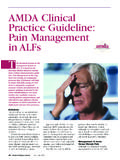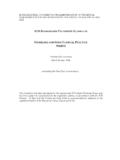Transcription of Pan Pacific Clinical Practice Guideline for the …
1 Pan Pacific Clinical Practice Guideline for the Prevention and management of Pressure InjurySINGAPOREWOUNDHEALINGSOCIETYPan Pacific Guideline for the Prevention and management of Pressure Injury (2012)Published by the Australian Wound management Association in collaboration with the New Zealand Wound Care Society, Hong Kong Enterostomal Therapists Association and the Wound Healing Society (Singapore).Copyright the Australian Wound management Association Inc. 2012. All rights reserved. Apart from any fair dealing for the purposes of private study, research or review, as permitted under the Copyright Act, no part may be reproduced or copied in any form or by any means without the written permission of the Australian Wound management permission to reproduce information refer to the following websites:Australian Wound management Association: New Zealand Wound Care Society: Hong Kong Enterostomal Therapists Association: Healing Society (Singapore): citation:Australian Wound management Association.
2 Pan Pacific Clinical Practice Guideline for the Prevention and management of Pressure Injury. Cambridge Media Osborne Park, WA: 2012. ISBN Print: 978-0-9807842-5-1 ISBN Online: 978-0-9807842-3-7 Contact:The Australian Wound management Association at Guideline was developed by the Australian Wound management Association in collaboration with the New Zealand Wound Care Society, New Zealand Wound Care Society, Nursing Service, Hong Kong Enterostomal Therapists Association and the Wound Healing Society (Singapore). The Guideline presents a comprehensive review of the assessment, diagnosis, management and prevention of pressure injuries within the Australian, New Zealand, Hong Kong and Singapore healthcare context, based on the best evidence available up to August 2011. The Guideline is designed to provide information to assist in decision-making and is based on the best information available at the date of compilation.
3 This document is a general guide to appropriate Practice , to be implemented by a qualified health professional subject to his or her Clinical judgment of each individual case and in consideration of the patient s personal preferences. The Guideline should be implemented in a culturally safe and respectful manner in accordance with the principles of protection, participation and of this Guideline can be downloaded from the following websites:Australian Wound management Association: New Zealand Wound Care Society: Kong Enterostomal Therapists Association: Healing Society (Singapore): Pacific Clinical Practice Guideline for the Prevention and management of Pressure Injurypage 1 Table of Development Steering Development used reference flow OF of the and target of the DEVELOPMENT PROCESS , appraisal & selection of existing Clinical .
4 Appraisal and synthesis of new and grading of recommendations for consensus based of Practice of the preparations and wound date and strategy of INJURY RISK associated with an increased risk of pressure patients at risk of pressure assessment and validity of pressure injury risk assessment scales for and validity of pressure injury risk assessment scales for screening and of OF PRESSURE nutrition 39page 2 Pan Pacific Clinical Practice Guideline for the Prevention and management of Pressure surfaces of support (constant low pressure) support (alternating pressure) support a support the patient s heels in bed support the patient in the seated surfaces and positioning in the operating surfaces in the operating the patient for AND MONITORING OF PRESSURE injury assessment and and injury healing assessment of injury PAIN ASSOCIATED WITH PRESSURE experience of pressure injury pain duration and associated with assessment pain associated with pressure FOR THE TREATMENT OF PRESSURE protein and disease-specific or multivitamin containing bed and wound Clinical iodine medical grade antiseptic dressing selection81 Pan Pacific Clinical Practice Guideline for the Prevention and management of Pressure Injurypage pressure wound therapy electromagnetic light
5 Professional AND COST pressure injury reduction initiatives in the organisation of a new classification implications of the NOT CURRENTLY FOR WHICH THERE IS INSUFFICIENT biological surfaces FOR FURTHER A Guideline Development Steering Committee and Guideline Development Groups102 APPENDIX B Excluded Literature108 APPENDIX C Primary Search Strategy110 APPENDIX D Critical Appraisals and Quality of Research 111 APPENDIX E Validated Assessment Tools114 APPENDIX F Braden Scale for Predicting Pressure Sore Risk115 APPENDIX G Norton Scale116 APPENDIX H Waterlow Score117 APPENDIX I Braden Q Scale118 Table of tables and figuresPageTable AGREE scores of appraised existing guidelines20 Table NHMRC levels of evidence21 Figure Review process23 Table Body of evidence assessment matrix24 Table Recommendation grades24 Figure Factors associated with increased risk of pressure injury28 Table Reliability and validity of pressure injury risk assessment tools for adults32 Table Reliability and validity of pressure injury risk assessment tools for children32 Table Types of support surfaces42 Table Consensus on minimum recommendations for high specification foam mattresses43 Table Considerations in selecting a support surface47 Table NPUAP/EPUAP pressure injury classification system59 Table Factors associated with pressure injury pain63 Table Membership of Steering Committee and Development Groups103 Table Conflict of interest declarations106 Table Excluded guidelines and literature107 Table.
6 Critical appraisal of included SRs111 Table : Quality of research included in SRs112 Table : Validated assessment tools114page 4 Pan Pacific Clinical Practice Guideline for the Prevention and management of Pressure Injury1. INTRODUCTIOND espite a general consensus that pressure injuries (PIs) are preventable adverse events, they continue to remain a problem in all health care settings. In addition to the significant financial costs (to health services and patients), PIs are associated with significant social cost in terms of increased morbidity and mortality, pain, discomfort, decreased mobility, loss of independence, social isolation and lost work time. As health care professionals, these are factors that warrant our Australian Wound management Association (AWMA) together with partners in New Zealand, Singapore and Hong Kong aims to optimise the prevention, assessment and management of PIs via the dissemination of this Guideline that represents best available evidence, and simplify Clinical decision making processes for health care professionals.
7 This Guideline , developed by a multidisciplinary international team of experts, presents a comprehensive review of the prevention, assessment and management of PIs within the Australian, New Zealand, Hong Kong, Singapore and Pan Pacific region healthcare context, based on the best evidence available up to August 2011. The guidelines offer recommendations to help health care professionals provide quality care for patients of all ages and across a range of health care settings, such as acute care, post-acute care, community settings and long term care. The Guideline is designed to provide information to assist in decision-making and is based on the best information available at the date of compilation. The Guideline is not intended to have a regulatory effect.
8 management of PI requires a multidisciplinary approach. This document is a general guide to appropriate Practice , to be implemented by qualified health professionals subject to their Clinical judgment of each individual case and in consideration of the patient s personal preferences and available resources. The Guideline should be implemented in a culturally safe and respectful manner in accordance with the principles of protection, participation and AcknowledgementsThis project was financed by the AWMA and conducted by the AWMA experts in conjunction with independent, multidisciplinary experts throughout Australia, New Zealand, Singapore and Hong Kong. The Guideline Development Steering Committee had full editorial following experts were involved in the appraisal of literature and development of the recommendations contained in the Guideline : Guideline Development Steering CommitteeAustraliaKeryln Carville (Chair), Adj.
9 Professor; RN; STN(Cred); PhDJudith Barker, Nurse Practitioner (Wound Mmt); RN; NP; STN; MN(NP); BHlthSc (Nurs); Sean Fitzgerald, Consumer RepresentativeEmily Haesler, Methodologist, Academic Researcher; BN, PGradDip(AdvNsg)Judith Manning, Clinical Nurse (Wound MMt); RN; MA; McGuiness, AWMA President; Assoc. Professor; RN; PhD; MNS; BN; DipTTracy Nowicki, Clinical Nurse Consultant; RNJenny Prentice, RN; PhDRobyn Rayner, Clinical Nurse (Wound Mmt); RN; M Wound Care; PGrad Health Admin; BSci(Nursing); Jan Rice, Clinical Nurse Educator RN; M Wound Care; MRCNA; Cert. Plastic & Reconstructive Surgery; FAWMAM ichael Woodward, Assoc. Professor; MB; BS; MD; FRACPC atherine Young, Occupational Therapist; Wheelchair Seating Consultant; BAppSc (OT); Cert Family Dynamics PU PreventionClarissa Young, Clinical Nurse Consultant (Wound Mmt); RN; MCN; MNS (NP)BN; New ZealandPam Mitchell, Clinical Nurse Consultant (Wound Mmt); MN ; Dip N; PGDip WHTR (Wales); Emil Schmidt, RN, BN Hon.
10 PG cert. WCNS, MCNA (NZ)Singapore Susie Goh, RN, STN, PGrad Cert. Tissue ViabilityPan Pacific Clinical Practice Guideline for the Prevention and management of Pressure Injurypage 5 Hong Kong Susan Law, Advanced Practice Nurse (Wound MMt); RN; RM; MScN ; BScN; Guideline Development GroupsMargo Asimus, Nurse Practitioner (Wound Mmt)Elizabeth Abraham, Occupational TherapistJudith Barker, Nurse Practitioner (Wound Mmt); RN; NP; MN(NP) BHlthSc (Nurs); Byrnes, Nurse Practitioner (Wound Mmt); RN; NP; MN(NP) STN; DipHlthSc (Nurs); STN Keryln Carville (Chair), Assoc. Professor; RN; STN(Cred); PhDKerrie Coleman, Nurse Practitioner Complex Wound Mmt; MNclinical (Wound Mmt),MN(Chronic Disease) BNSc, DipApScMonique Covey, Clinical Dietitian; APD; BSc(Nutrition) HonsJenny Davenport, Clinical Nurse Educator; RN; STN(Cred); Cert.










